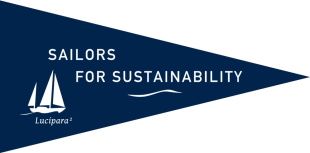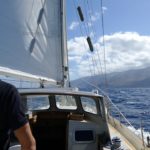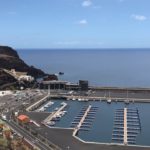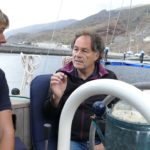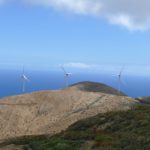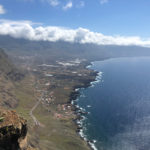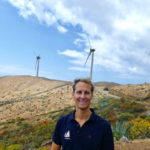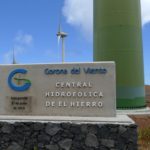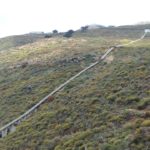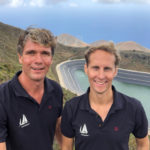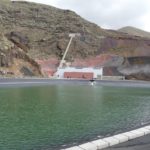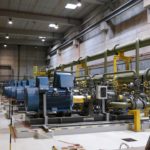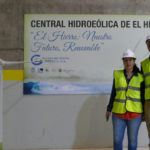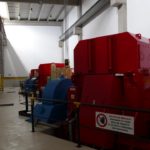Energy on El Hierro (ESP)
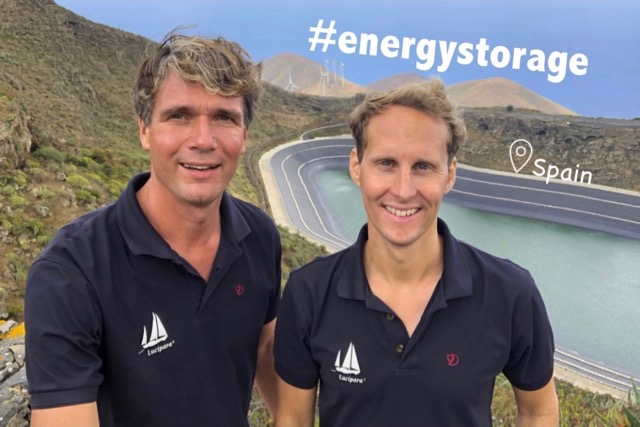
On the small and remote Spanish island El Hierro, we visit a world-leading renewable energy storage solution that combines wind- and hydropower!
Contributes to achieving the following UN Sustainable Development Goals:
From the Canary Island of La Palma we sail in one day to our last European destination, at least for the foreseeable future: neighbouring island El Hierro. Propelled by a firm and constant northeast trade wind, we sail south and quickly approach the mountainous, smallest of the seven main Canary Islands. When we arrive at the marina of Puerto de Estaca, we can see them: wind turbines. “The reason for our visit!” Floris exclaims enthusiastically.
Renewable Energy Challenge
The next day we welcome former island council member and sustainability expert Javier Morales on board. He tells us that the island is so far away from the mainland, that no electricity cable was ever laid. Instead, a diesel-fired power station was built on the island. “In order to become less dependent on expensive and polluting diesel to generate our electricity, we were looking for a smart, renewable energy solution”, Javier explains. “The preferred source of renewable energy here is wind power, since we have a lot of wind. And wind turbines don’t take a lot of space. That is important, because on our island a lot of space is allocated to nature reserves. Our challenge was to guarantee a constant supply of electricity for the 10,000 islanders, despite the intermittent nature of wind energy.”
A Unique Combination of Wind and Water
Javier describes how they solved it. “We made optimal use of the natural and geological conditions on our island. Besides windy, El Hierro is also mountainous. Therefore, we decided to combine wind power with hydropower. We built five wind turbines with a total capacity of 11.5 MW, as well as two water reservoirs. One at sea level and a second one at an altitude of 700 meters. With energy generated by the wind mills we can pump water to the upper reservoir. We can control how much water we release from the upper reservoir to the lower one. A hydroelectric power station can thus supplement energy needed to meet the island’s needs as well as guarantee a constant supply of electricity.”
In this setup, the upper water reservoir functions as a gigantic battery. Javier tells us proudly that the combined wind and hydro power plant is the first of its kind in the world.
Embedded in the Landscape
To get a closer look of the wind turbines and upper reservoir, we drive up a winding mountain road. Just past the town of Valverde we reach the wind turbines. “Just like us, they are powered by the trade winds”, Ivar remarks. Only five are needed for the energy supply of the island. “How powerful these turbines must be”, Floris considers.
We continue further uphill to the upper water reservoir and regularly stop for the view. In the distance, ocean waves violently break on the basalt cliffs in white foam. Dense, dark-green pine forests grow on the steep slopes defying the laws of gravity, it seems. When we reach the water reservoir, we see that it is constructed in a natural basin in the mountainous landscape. The pipelines are built out of sight in a valley behind the reservoir. All installations are hardly visible to keep the disturbance of the natural environment minimal.
We notice that the water reservoir is not full. Curious about the technical aspects of the island’s energy generation, we arrange a visit at the energy company that manages the plant, Gorona del Viento.
Existing Technology
Communication officer Candelaria Sanchez welcomes us at the company’s headquarters close to the lower water reservoir. She explains that Gorona del Viento is a public-private partnership consisting of three partners: the El Hierro Island Council, Spanish energy company Endesa, and the Canary Islands Technological Institute. She takes us to abuilding next to lower water reservoir. It houses large turbines, which generate electricity from water falling from the upper to the lower reservoir. Another building around the corner houses the installations to pump the water back up to the upper reservoir. “It’s all existing technology”, Candelaria explains. “The pumps are standard and the turbines are also used in many other hydroelectric power stations around the world.”
From engineer Alberto Castaneda we learn more about the operation. Since the plant’s inauguration in 2015, an increasing part of the island’s energy needs has been generated with renewable means. “The reliability of delivery is of great importance to us”, Alberto explains. “Although the trade winds are fairly constant, the amount of energy generated still fluctuates considerably from second to second.” He points to a large screen, which shows that the real-time energy production per wind turbine varies considerably. “That’s why we only put a small portion of the generated wind energy directly into the grid. Most of the energy is used to pump water to the upper reservoir. At the same time, we control the amount of electricity required with the hydroelectric power plant. Only if there is too little wind and the water level in the upper reservoir is too low, the old diesel generator will kick-in.”
How come the energy output keeps on increasing, we ask him. “We are learning to use the power station better and better”, Alberto answers. “In January 2017, we were able to supply the whole island with renewable energy for 18 consecutive days. On average throughout that year, we supplied more than fifty percent of the islands energy demands through renewable means.”
Alberto is hopeful for the future: “We see room for improvement. It is expected that the percentage of renewable energy in the electricity mix will increase even further as we keep getting better at managing the installations. You can check our progress, since the island’s energy mix is publicly accessible.”
How Much Does that Cost?
When Javier shows us sustainable farming and fishing examples on the island, we ask him about the financials of the island’s remarkable energy transition. “It’s probably not cheap to build all this”, Ivar comments. As member of the Island Council he was involved in the project. “It took 12 years of preparation, planning and fundraising,” Javier explains. “A total of €80 million was invested. The European Union subsidized around half of that, the rest was funded by the consortium of public and private parties. The payback period for the private parties is expected to be nine years. After that period the island community will save a lot of money, which can be spent on other things, such as solar panels on roofs or electric transport. This would stimulate the local economy and enable the islanders to use 100% renewable energy throughout the year.”
A World-Class Example
As we leave El Hierro, sailing with the trade winds towards Cabo Verde, we reflect on the island’s achievements. “It is no coincidence that a remote island has become a leading example of how to deal with the storage of renewable energy”, Ivar says. “They had to come up with a solution for the fluctuating power supply of wind energy because they had no connection with the mainland.” “Still, the same systems can be applied in many more places!” Floris adds. “The technology has been around for a long time, after all.” We are impressed that such a small island community has managed to become such an inspiring example for the world. If that doesn’t give positive energy…!
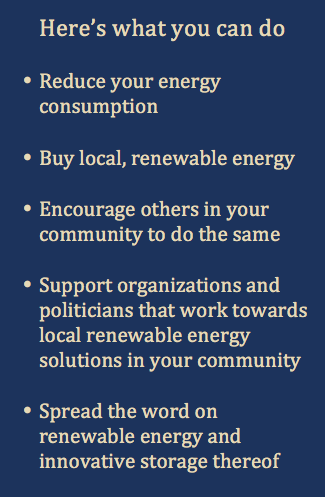
Related Sustainable Solutions

Geothermal Energy (NZL)
We explore how the Kiwis make smart use of energy from the Earth and learn that we don’t need fossil fuel-based electricity at all.

Energy Storage (ESP)
On the small and remote Spanish island El Hierro, we visit a world-leading renewable energy storage solution that combines wind- and hydropower!

Solar Energy (ESP)
In one hour enough solar energy reaches the Earth to provide energy for everyone for a year. But how will we harvest and store it? Spain has the solution.
